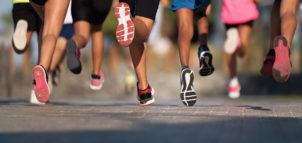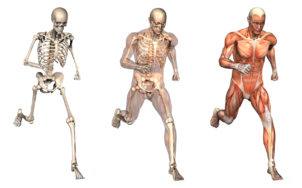 These days, the world of physical fitness finds itself mired in an interesting conundrum. Perhaps you’ve noticed? On the one hand, our North American lifestyle is increasingly sedentary. We’re hooked up to electronics, we have machines that do the bulk of our physical labour for us, and we use still more machines to take us to the places we want to go. In years gone by, the daily activity of life was often enough to keep people at least moderately ‘fit.’ Today though, most people sit for many hours every day, and have to exert an intentional effort to get enough exercise to even minimally support long term health. On the other hand, there are extreme fitness classes, bootcamps and all manner of high-intensity get-fit-NOW kind of programs. There seems to be a growing disconnect between our increasingly less-than-fit population, and those who are delving into ever more extreme activities. I believe it is the responsibility of those of us working physical health professions to begin to close that gap. And I think the holistic skills of movement professionals are an important part of that process.
These days, the world of physical fitness finds itself mired in an interesting conundrum. Perhaps you’ve noticed? On the one hand, our North American lifestyle is increasingly sedentary. We’re hooked up to electronics, we have machines that do the bulk of our physical labour for us, and we use still more machines to take us to the places we want to go. In years gone by, the daily activity of life was often enough to keep people at least moderately ‘fit.’ Today though, most people sit for many hours every day, and have to exert an intentional effort to get enough exercise to even minimally support long term health. On the other hand, there are extreme fitness classes, bootcamps and all manner of high-intensity get-fit-NOW kind of programs. There seems to be a growing disconnect between our increasingly less-than-fit population, and those who are delving into ever more extreme activities. I believe it is the responsibility of those of us working physical health professions to begin to close that gap. And I think the holistic skills of movement professionals are an important part of that process.
We have fast-paced lives, so naturally we gravitate to activities that will keep us looking and feeling healthy in the shortest possible amount of time. If you work in the realm of physical activity, you know that many of our clients, athletes and patients are drawn to the quick fix. They want results now. We respond by packing intense physical experiences into the shortest amount of time possible. And for many, that approach works well enough. Our clients walk away with the sense that they worked hard to get great results, and we can feel good in knowing that we’ve helped them to look & feel great, diminish their risk for disease, manage their weight, move with more energy & power. But the quick fix misses some important stuff – and quality of movement is one of the first to go. Why should we care? As long as we get the workout in, who cares if it’s pretty, right? Wrong!
Biomechanical imbalances, postural issues, movement and breath pattern dysfunction; these are things we all deal with, but we don’t typically notice them until they’re really creating problems for us. But guess what? Practice makes permanent. The more often we repeat dysfunctional motions, the deeper that dysfunction settles into our systems. If we’re blithely ignorant of our own movement pattern dysfunctions, and happily travel from the office to intense workouts and back, our dysfunctions will begin to catch up to us. The compensations we’ve developed over time are more than likely to magnify. And these compensations tend to stack up in the body exponentially. At some point, those compensations add up to injury, or create effort and struggle where once there was ease.
Imagine the power of learning to move really well from the outset, unleashing FULL movement potential? Picture having a keen awareness of how the body feels in motion – when things are going well and also when they’re not. Wouldn’t it be great to understand how the body works – from the inside, and not just in terms of muscles and the skeleton – but as a dynamic web of intricate and interconnected systems?
Increasingly, there is a need for what I call movement professionals. These are people who, in addition to creating programs that support the kinds of movement you want to do most in your life, also create an environment where you can learn about how your body works, how it moves and how best to keep it healthy all the time – not just while you’re performing a convoluted yoga pose, or crossfit heroics. These are people who look at where you are, how you’re moving now, and where you want to be. What are your postural & movement patterns? Where do you initiate movement from? Where are the “stops” in your body – the ones preventing fluid movement? How do the various pieces of your life manifest themselves in your movement, and how is it possible to create more fluidity, ease, mobility and power? These movement professionals look at the overall motion of the whole body as well as the balance of motion through individual systems.
In my experience, movement professionals can be found in many different professions. They are people who look beyond the protocols of their individual disciplines to really see the people with whom they are working. Then, they use their specialized skills & experience to serve the movement needs of the individuals with whom they are working. They can be Pilates & yoga instructors, fitness trainers & conditioning coaches. They can be physiotherapists, kinesiologists, and other movement therapists. They can be dance teachers or sports coaches. Anyone who is teaching movement, with an interest in the quality of motion as well as the intensity, progression & duration of exercises is, in my books a movement professional. And the world needs MORE of you!
Fitness, sports training and even health care have come to be something of a numbers game. We are hooked on the stats. Heart rates, calories, repetitions, weight loads, percentages… we seem to measure everything from a numbers perspective. Numbers are important landmarking and measuring tools. They give us a sense of what we may have accomplished, or how far we have to go before we reach a goal. From a policy perspective, keeping track of numbers helps us craft policies around what people need. But the numbers don’t address quality of movement – which to my mind, is as important as any set of numbers you want to put up.
 For me, quality of movement is where it starts. When people begin to understand their own bodies in motion, and start to find a real felt-sense connection to them, they begin to experience a sense of confidence and mastery around their own physicality. They can take the lessons they learn about their bodies from various different sources and begin to apply them in their own lives. Their physical training then goes beyond “the class,” and into their daily activities – whether those activities include skiing in the World Cup, running a local 10K or playing with the kids after school. At that point, they’ve found themselves in their movement, opening the door for truly transformative results. You’re probably familiar with the old adage, “give a man a fish and he eats for a day, teach a man to fish and you feed him for a lifetime.” Movement professionals teach their clients to know and move their bodies with knowledge and awareness – giving them tools to last a lifetime.
For me, quality of movement is where it starts. When people begin to understand their own bodies in motion, and start to find a real felt-sense connection to them, they begin to experience a sense of confidence and mastery around their own physicality. They can take the lessons they learn about their bodies from various different sources and begin to apply them in their own lives. Their physical training then goes beyond “the class,” and into their daily activities – whether those activities include skiing in the World Cup, running a local 10K or playing with the kids after school. At that point, they’ve found themselves in their movement, opening the door for truly transformative results. You’re probably familiar with the old adage, “give a man a fish and he eats for a day, teach a man to fish and you feed him for a lifetime.” Movement professionals teach their clients to know and move their bodies with knowledge and awareness – giving them tools to last a lifetime.
So if you’re a movement professional – keep up the good work! We need more people like you to help us all connect to ourselves and our movement – making it easier to do the things we love to do. Whether you’re working in a high-intensity environment or in a more meditative, contemplative one, the work you do to support your clients in finding their best movement will improve their efforts at achieving their movement goals, whatever they may be.
And if you’d like to hone your skills as a movement professional, check out the Moving Spirit education curriculum. We’ve got programs to help you deepen your impact with your clients. Their success is your success!
